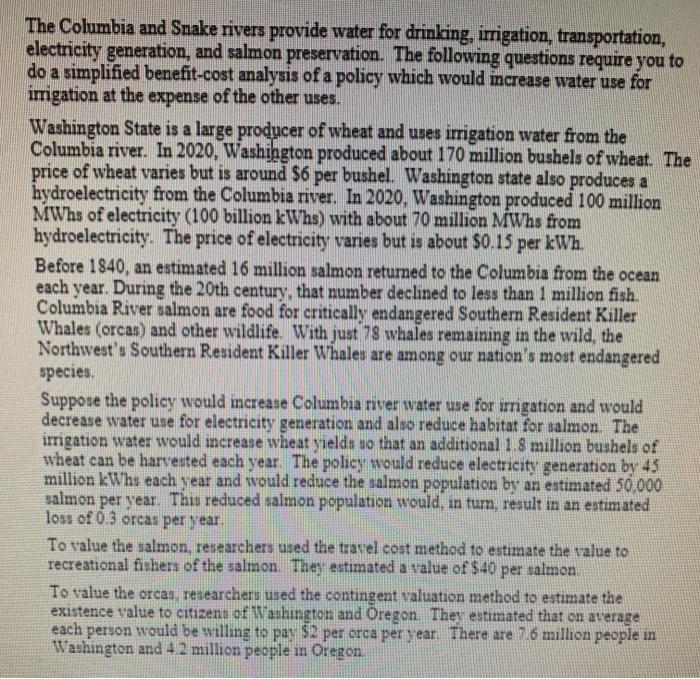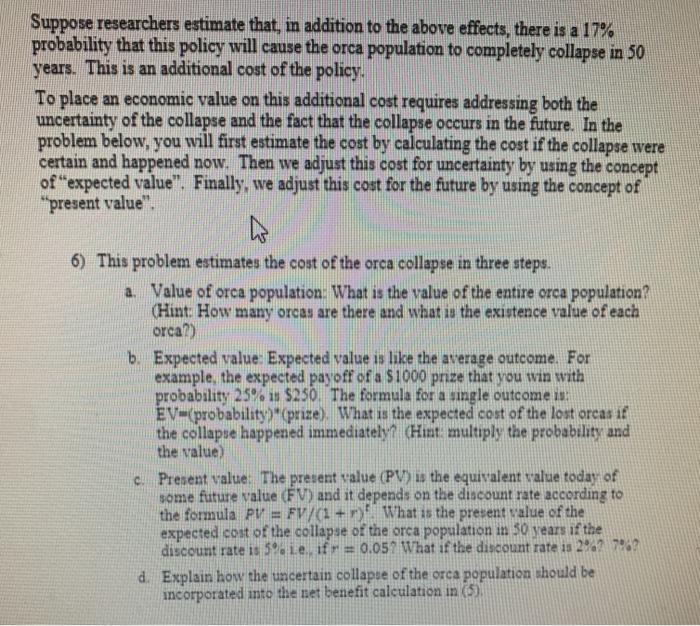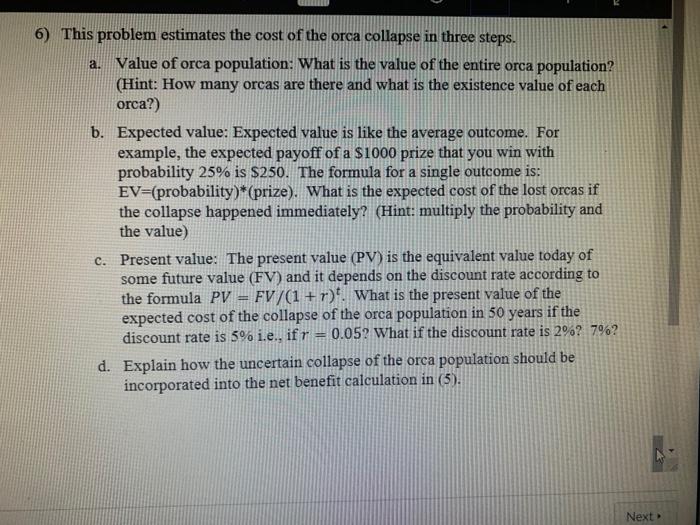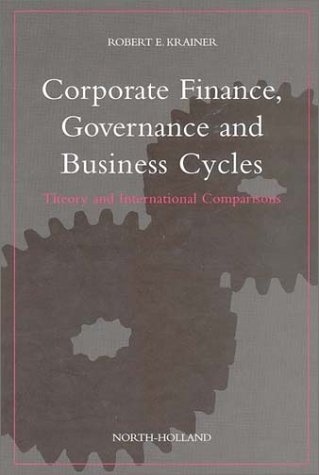The Columbia and Snake rivers provide water for drinking, irrigation, transportation, electricity generation, and salmon preservation. The following questions require you to do a simplified benefit-cost analysis of a policy which would increase water use for irrigation at the expense of the other uses. Washington State is a large producer of wheat and uses irrigation water from the Columbia river. In 2020, Washington produced about 170 million bushels of wheat. The price of wheat varies but is around $6 per bushel. Washington state also produces a hydroelectricity from the Columbia river. In 2020, Washington produced 100 million MWhs of electricity (100 billion kWhs) with about 70 million MWhs from hydroelectricity. The price of electricity varies but is about $0.15 per kWh. Before 1840, an estimated 16 million salmon retumed to the Columbia from the ocean each year. During the 20th century, that number declined to less than 1 million fish. Columbia River salmon are food for critically endangered Southern Resident Killer Whales (orcas) and other wildlife. With just 78 whales remaining in the wild, the Northwest's Southern Resident Killer Whales are among our nation's most endangered species. Suppose the policy would increase Columbia river water use for irrigation and would decrease water use for electricity generation and also reduce habitat for salmon. The irrigation water would increase wheat yields so that an additional 1.8 million bushels of wheat can be harvested each year. The policy would reduce electricity generation by 45 million kWhs each year and would reduce the salmon population by an estimated 50,000 salmon per year. This reduced salmon population would, in turn, result in an estimated loss of 0.3 orcas per year. To value the salmon, researchers used the travel cost method to estimate the value to recreational fishers of the salmon. They estimated a value of $40 per salmon To value the orcas, researchers used the contingent valuation method to estimate the existence value to citizens of Washington and Oregon. They estimated that on average each person would be willing to pay $2 per orca per year. There are 7.6 million people in Washington and 42 million people in Oregon. Suppose researchers estimate that, in addition to the above effects, there is a 17% probability that this policy will cause the orca population to completely collapse in 50 years. This is an additional cost of the policy. To place an economic value on this additional cost requires addressing both the uncertainty of the collapse and the fact that the collapse occurs in the future. In the problem below, you will first estimate the cost by calculating the cost if the collapse were certain and happened now. Then we adjust this cost for uncertainty by using the concept of "expected value. Finally, we adjust this cost for the future by using the concept of "present value" 6) This problem estimates the cost of the orca collapse in three steps. a. Value of orca population: What is the value of the entire orca population? (Hint: How many orcas are there and what is the existence value of each orca?) b. Expected value: Expected value is like the average outcome. For example, the expected payoff of a $1000 prize that you win with probability 25% is $250. The formula for a single outcome is EV-(probability)"(prize). What is the expected cost of the lost orcas if the collapse happened immediatelyi (Hint: multiply the probability and the value Present value. The present value (PV) is the equivalent value today of some future value (FV) and it depends on the discount rate according to the formula pt = F/(1+r) What is the present value of the expected cost of the collapse of the orca population in 30 years if the discount rate is 5e, if = 0.05? What if the discount rate is 2% 7%? d. Explain how the uncertain collapse of the orca population should be incorporated into the net benefit calculation in (5) 6) This problem estimates the cost of the orca collapse in three steps. a. Value of orca population: What is the value of the entire orca population? (Hint: How many orcas are there and what is the existence value of each orca?) b. Expected value: Expected value is like the average outcome. For example, the expected payoff of a $1000 prize that you win with probability 25% is $250. The formula for a single outcome is: EV=(probability)*(prize). What is the expected cost of the lost orcas if the collapse happened immediately? (Hint: multiply the probability and the value) C. Present value: The present value (PV) is the equivalent value today of some future value (FV) and it depends on the discount rate according to the formula PV = FV/(1+r). What is the present value of the expected cost of the collapse of the orca population in 50 years if the discount rate is 5% i.e., ifr 0.052 What if the discount rate is 2%? 7%? d. Explain how the uncertain collapse of the orca population should be incorporated into the net benefit calculation in (5). Next The Columbia and Snake rivers provide water for drinking, irrigation, transportation, electricity generation, and salmon preservation. The following questions require you to do a simplified benefit-cost analysis of a policy which would increase water use for irrigation at the expense of the other uses. Washington State is a large producer of wheat and uses irrigation water from the Columbia river. In 2020, Washington produced about 170 million bushels of wheat. The price of wheat varies but is around $6 per bushel. Washington state also produces a hydroelectricity from the Columbia river. In 2020, Washington produced 100 million MWhs of electricity (100 billion kWhs) with about 70 million MWhs from hydroelectricity. The price of electricity varies but is about $0.15 per kWh. Before 1840, an estimated 16 million salmon retumed to the Columbia from the ocean each year. During the 20th century, that number declined to less than 1 million fish. Columbia River salmon are food for critically endangered Southern Resident Killer Whales (orcas) and other wildlife. With just 78 whales remaining in the wild, the Northwest's Southern Resident Killer Whales are among our nation's most endangered species. Suppose the policy would increase Columbia river water use for irrigation and would decrease water use for electricity generation and also reduce habitat for salmon. The irrigation water would increase wheat yields so that an additional 1.8 million bushels of wheat can be harvested each year. The policy would reduce electricity generation by 45 million kWhs each year and would reduce the salmon population by an estimated 50,000 salmon per year. This reduced salmon population would, in turn, result in an estimated loss of 0.3 orcas per year. To value the salmon, researchers used the travel cost method to estimate the value to recreational fishers of the salmon. They estimated a value of $40 per salmon To value the orcas, researchers used the contingent valuation method to estimate the existence value to citizens of Washington and Oregon. They estimated that on average each person would be willing to pay $2 per orca per year. There are 7.6 million people in Washington and 42 million people in Oregon. Suppose researchers estimate that, in addition to the above effects, there is a 17% probability that this policy will cause the orca population to completely collapse in 50 years. This is an additional cost of the policy. To place an economic value on this additional cost requires addressing both the uncertainty of the collapse and the fact that the collapse occurs in the future. In the problem below, you will first estimate the cost by calculating the cost if the collapse were certain and happened now. Then we adjust this cost for uncertainty by using the concept of "expected value. Finally, we adjust this cost for the future by using the concept of "present value" 6) This problem estimates the cost of the orca collapse in three steps. a. Value of orca population: What is the value of the entire orca population? (Hint: How many orcas are there and what is the existence value of each orca?) b. Expected value: Expected value is like the average outcome. For example, the expected payoff of a $1000 prize that you win with probability 25% is $250. The formula for a single outcome is EV-(probability)"(prize). What is the expected cost of the lost orcas if the collapse happened immediatelyi (Hint: multiply the probability and the value Present value. The present value (PV) is the equivalent value today of some future value (FV) and it depends on the discount rate according to the formula pt = F/(1+r) What is the present value of the expected cost of the collapse of the orca population in 30 years if the discount rate is 5e, if = 0.05? What if the discount rate is 2% 7%? d. Explain how the uncertain collapse of the orca population should be incorporated into the net benefit calculation in (5) 6) This problem estimates the cost of the orca collapse in three steps. a. Value of orca population: What is the value of the entire orca population? (Hint: How many orcas are there and what is the existence value of each orca?) b. Expected value: Expected value is like the average outcome. For example, the expected payoff of a $1000 prize that you win with probability 25% is $250. The formula for a single outcome is: EV=(probability)*(prize). What is the expected cost of the lost orcas if the collapse happened immediately? (Hint: multiply the probability and the value) C. Present value: The present value (PV) is the equivalent value today of some future value (FV) and it depends on the discount rate according to the formula PV = FV/(1+r). What is the present value of the expected cost of the collapse of the orca population in 50 years if the discount rate is 5% i.e., ifr 0.052 What if the discount rate is 2%? 7%? d. Explain how the uncertain collapse of the orca population should be incorporated into the net benefit calculation in (5). Next









